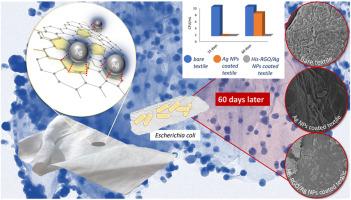Reduced graphene oxide-histidine-silver nanocomposite coating with antibacterial activity for abdominal biomedical textiles
IF 11.6
2区 材料科学
Q1 CHEMISTRY, PHYSICAL
引用次数: 0
Abstract
The synthesis and characterization of a novel antibacterial hybrid nanocomposite composed of reduced graphene oxide (RGO) functionalized with histidine and decorated with Ag nanoparticles (NPs) is reported. The material was developed via an in situ colloidal approach, performed in water at ice bath temperature. Histidine was selected as molecular linker due to its unique physicochemical properties: (i) ability to exfoliate RGO and enhance its dispersion in aqueous media, (ii) π–π aromatic stacking interactions with the graphene basal plane, and (iii) presence of imidazole and amine groups that provide coordination sites for Ag+ ions, enabling controlled nucleation and anchoring of monodispersed Ag NPs. The nanocomposite structure was finely tuned by systematically optimizing synthetic parameters, and each parameter was evaluated through morphological and spectroscopic characterization to assess NP size distribution and anchoring density. The nanocomposite was applied as coating on cotton fabrics and tested for the antibacterial activity against Escherichia coli (E. coli), following the ISO 20743:2021 quantitative standard protocol. The nanocomposite demonstrated superior and more stable antibacterial performance compared to Ag NP coatings synthesized with comparable size and surface properties. MTS assays confirmed that the modified textiles did not significantly impair cell viability. Given its colloidal stability, sustained antibacterial efficacy, and safety profile, the nanocomposite represents a robust platform for functional coatings in biomedical textiles, wound dressings and surgical fabrics, particularly suited to abdominal and intestinal procedures where E. coli contamination is a major concern.

腹部生物医用纺织品中具有抗菌活性的还原氧化石墨烯-组氨酸-银纳米复合涂层
报道了一种新型抗菌杂化纳米复合材料的合成和表征,该复合材料由组氨酸功能化的还原氧化石墨烯(RGO)和银纳米粒子(NPs)修饰而成。该材料是通过原位胶体方法开发的,在冰浴温度下在水中进行。组氨酸被选为分子连接剂是因为其独特的物理化学性质:(1)能够剥离氧化石墨烯并增强其在水介质中的分散,(2)π -π芳香层与石墨烯基面相互作用,(3)咪唑和胺基的存在为Ag+离子提供配位,使单分散的Ag NPs能够控制成核和锚定。通过系统优化合成参数对纳米复合材料结构进行精细调整,并通过形态学和光谱表征对每个参数进行评估,以评估NP大小分布和锚定密度。将纳米复合材料涂覆在棉织物上,并按照ISO 20743:2021定量标准测试了其对大肠杆菌的抗菌活性。与具有相同尺寸和表面性能的银NP涂层相比,该纳米复合材料表现出更优异和更稳定的抗菌性能。MTS试验证实,改性纺织品没有显著损害细胞活力。鉴于其胶体稳定性、持续的抗菌功效和安全性,纳米复合材料代表了生物医学纺织品、伤口敷料和手术织物功能涂层的强大平台,特别适用于大肠杆菌污染主要关注的腹部和肠道手术。
本文章由计算机程序翻译,如有差异,请以英文原文为准。
求助全文
约1分钟内获得全文
求助全文
来源期刊

Carbon
工程技术-材料科学:综合
CiteScore
20.80
自引率
7.30%
发文量
0
审稿时长
23 days
期刊介绍:
The journal Carbon is an international multidisciplinary forum for communicating scientific advances in the field of carbon materials. It reports new findings related to the formation, structure, properties, behaviors, and technological applications of carbons. Carbons are a broad class of ordered or disordered solid phases composed primarily of elemental carbon, including but not limited to carbon black, carbon fibers and filaments, carbon nanotubes, diamond and diamond-like carbon, fullerenes, glassy carbon, graphite, graphene, graphene-oxide, porous carbons, pyrolytic carbon, and other sp2 and non-sp2 hybridized carbon systems. Carbon is the companion title to the open access journal Carbon Trends. Relevant application areas for carbon materials include biology and medicine, catalysis, electronic, optoelectronic, spintronic, high-frequency, and photonic devices, energy storage and conversion systems, environmental applications and water treatment, smart materials and systems, and structural and thermal applications.
 求助内容:
求助内容: 应助结果提醒方式:
应助结果提醒方式:


